How-to
Jun 26, 2024
What is Virtual Staging? A Guide to Digitally Transforming Real Estate Listings
Did you know that over 90% of home buyers start their search online? And it turns out, about 85% of them say photos are the most important factor when browsing homes on the web. It’s clear: the way a home looks online can make or break a sale.
What is Virtual Staging? A Guide to Digitally Transforming Real Estate Listings
In the bustling – and, let’s face it, crowded – real estate market, the challenge to capture the attention of potential buyers quickly and effectively has never been more important. Traditional staging, while powerful, comes with its set of logistical and financial hurdles. Enter virtual staging: a solution that combines technology with home design to showcase properties in their best light.
Did you know that over 90% of home buyers start their search online? And it turns out, about 85% of them say photos are the most important factor when browsing homes on the web. It’s clear: the way a home looks online can make or break a sale.
What is virtual staging?
Virtual staging is the process of digitally enhancing real estate listing photos by adding furniture, decor, and design elements. Unlike traditional physical staging where furniture and accessories are brought into the actual home, virtual staging allows you to transform empty or outdated rooms into beautifully staged environments without the hassle or expense of renting and moving furniture.
The virtual staging process typically involves taking high-quality photographs of the empty rooms, then using specialized software to insert realistic-looking furniture, artwork, rugs, plants, and other home decor items. The staged images aim to showcase the property's full potential and help prospective buyers envision how the space could look when furnished and decorated.

Photo: An example of an empty room that was virtually staged using Palazzo's AI-powered platform.
The benefits of virtual staging
Virtual staging offers several key advantages for real estate agents looking to showcase their properties in the best light.
Quicker, higher sales
One of the main benefits is the potential for faster sale times. Staged homes, whether physically or virtually, spend 73% less time on the market compared to those without staging (Professional Staging). By presenting a thoughtfully designed and decorated space, virtual staging helps prospective buyers envision themselves living in the home.
And the savings can add up - Realtor Magazine found that staged homes on the market sold for 25% more than homes without staging. Beautifully staged homes are more appealing to buyers, increasing the likelihood of securing offers and achieving higher sale prices.

Photo: A room staged in Palazzo, featuring a blend of traditional and rustic interior design elements.
Cost savings
One of the most compelling advantages of virtual staging over traditional physical staging is the cost savings involved. Physical staging can be a substantial expense, particularly for larger homes or those requiring extensive furniture and decor rentals. Homeguide found that physical staging typically costs between $1,600 and $2,400, with prices frequently going up to $5,500.
Virtual staging is a much more cost-effective solution. By leveraging digital technology, virtual staging companies can transform empty or poorly furnished spaces into beautifully curated environments at a fraction of the cost. In fact, a 2019 report found virtual staging was a staggering 97% less expensive than physical staging (Association of Realtors Research Group).
Flexibility
Virtual staging offers flexibility for both home buyers and realtors when it comes to showcasing a property. Unlike physical staging, which requires coordinating furniture deliveries and setup, virtual staging allows for rapid changes and experimentation with different design styles and layouts. This flexibility helps agents tailor the staging to specific buyer preferences and styles.
During live walk-throughs, realtors can use real-time tools like Palazzo to make on-the-spot changes based on client feedback. If a client can’t picture sleeping in a bedroom with white walls, they can be swapped out for their favorite color. When creating an online listing, realtors can meet the tastes of a wider range of clients by providing redesigns of the property in a few popular interior design styles.

Photo: A example of Palazzo's virtual staging interface, which allows for bulk upload of listing photos. The photos can be transformed into popular interior design styles at the click of a button.
Getting started with virtual staging
Virtual staging is a relatively straightforward process for real estate agents and home sellers.
The first step is to take high-quality, well-lit photos of the empty rooms you want to virtually stage. Make sure to capture each room from multiple angles to give a complete view of the space.
Next, you'll need to select a virtual staging company or platform. Many real estate photographers offer virtual staging as an additional service. Alternatively, there are online tools like Palazzo that allow you to upload your photos and virtually stage the rooms yourself through a user-friendly interface.
Once you have the final virtually staged photos, they can be used for online listings, marketing materials, and open house presentations. Virtual staging helps buyers envision the full potential of a property in a cost-effective way.
To learn more about how you can virtually stage properties in real time at low cost and effort, check out Palazzo's offerings for real estate.











